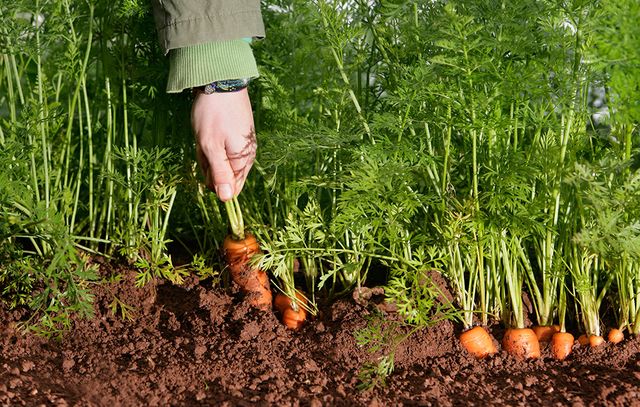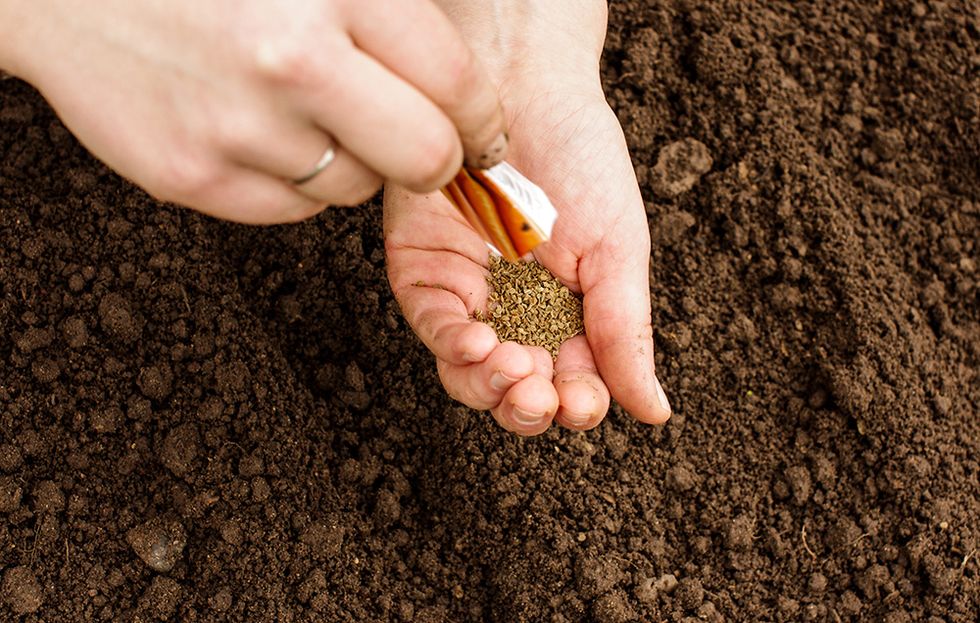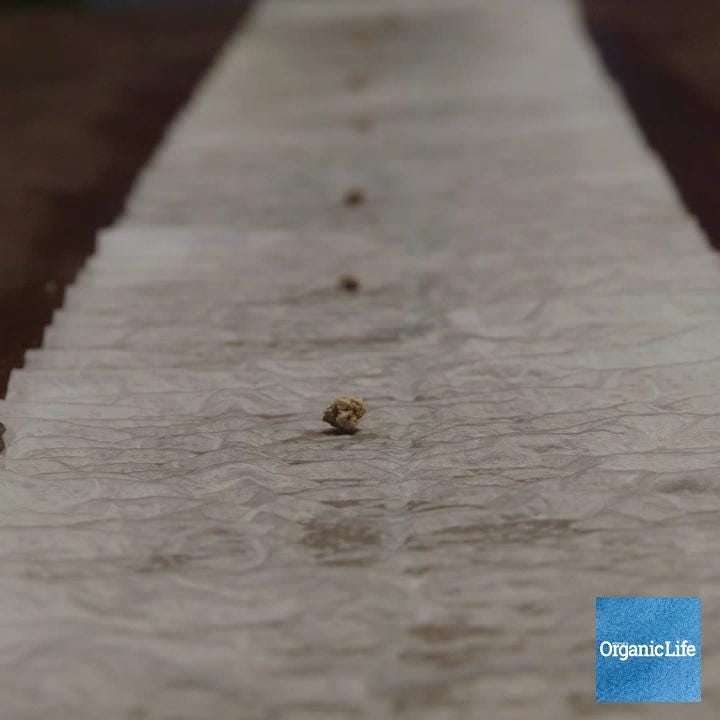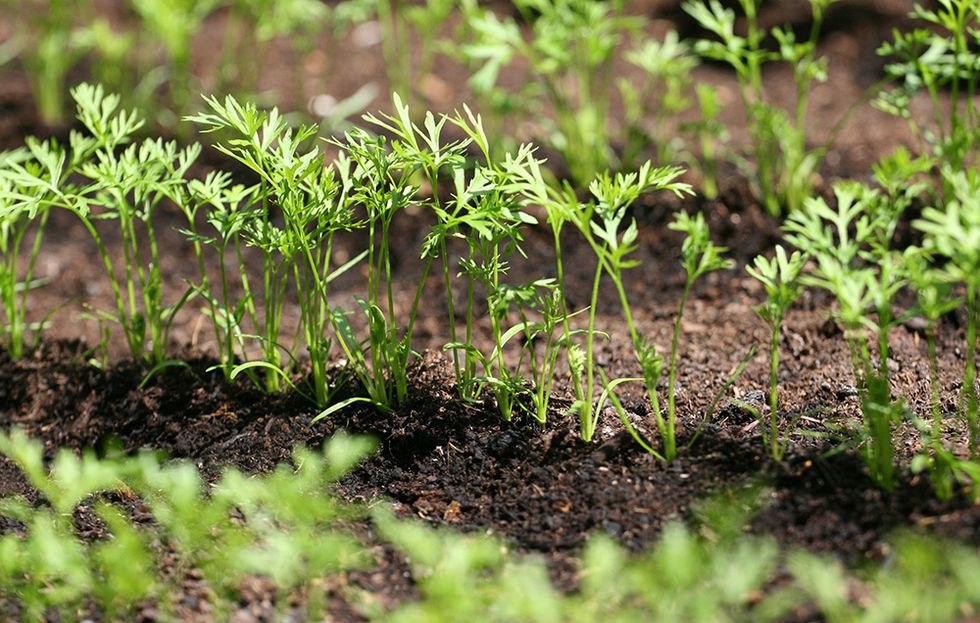Orange carrots are the traditional standard, but you can try planting white, yellow, crimson, or even purple carrots, too. More important than color, though, is choosing the right root size and shape to suit your soil. Carrot size and shape varies by type, and there are five major categories. Ball-type, Chantenay, and Danvers carrots have blocky shapes that can handle heavy or shallow soil, while slender Nantes and Imperator carrots need deep, loose soil. All types are available in early and late cultivars; many are disease-and crack-resistant. Some catalogs don’t describe how to plant carrots by type, but will point out which cultivars do better in heavy or poor soil.
(Whether you're starting your first garden or switching to organic, Rodale’s Basic Organic Gardening has all the answers and advice you need—get your copy today!)
How To Plant
To produce the best crop possible, double-dig your planting area or build up a raised bed. Loose, rock-free soil is the goal. If you have heavy soil, add plenty of mature compost.
Start sowing this cool-weather crop 3 weeks before the last expected frost; plant again every 2 to 3 weeks after that. Most cultivars take 70 to 80 days to mature, so sow your last planting 2 to 3 months before the first expected fall frost. In Zone 8 and warmer, plant carrots in fall or winter.
Try this trick for planting tiny seeds evenly:
Rake the soil free of lumps and stones. Broadcast the tiny seeds, or for easier weeding, plant in rows. Put a pinch of about six seeds to the inch. They will take 1 to 3 weeks to sprout (they germinate more slowly in cold soil than in warm), so you can always mix in a few quick-growing radish seeds to mark the rows. Cover with ¼ to ½ inch of screened compost, potting mix, or sand—a little more in warm, dry areas—to make it easier for the delicate seedlings to emerge. Water gently to avoid washing seeds away; keep the soil continuously moist for best germination.
Growing Guidelines
Thin to 1 inch apart when the tops are 2 inches high, and be thorough, because crowded carrots will produce crooked roots. Thin again 2 weeks later to 3 to 4 inches apart.
Related: 26 Plants You Should Always Grow Side-By-Side
As the seedlings develop, gradually apply mulch to maintain an even moisture level and reduce weed problems. It’s best never to let young carrot plants dry out. However, if the soil dries out completely between waterings, gradually remoisten the bed over a period of days; a sudden drenching may cause the roots to split. Carrots’ feeder roots are easily damaged, so hand pull any weeds that push through the mulch, or cut them off just below the soil surface. Cover carrot crowns, which push up through the soil as they mature, with mulch or soil to prevent them from becoming green and bitter.
Troubleshooting Problems
The biggest threats to carrots are four-footed critters such as deer, gophers, woodchucks, and rabbits. (Here's how to keep animal pests from destroying your garden.) Otherwise, carrots are fairly problem-free, though there are a few insect pests and plant disease you might run into.
Keep an eye out—particularly in the Northwest—for carrot rust flies, which look like small green houseflies with yellow heads and red eyes. Their eggs hatch into whitish larvae that burrow into roots. Infested roots turn dark red and the leaves black. Infestations usually occur in the early spring, so one solution is to delay planting until early summer, when damage is less likely. Or cover plants with a floating row cover to keep flies away.
Parsleyworms are green caterpillars with black stripes, white or yellow dots, and little orange horns. They feed on carrot foliage, but they are the larval stage of black swallowtail butterflies, so if you spot them on your carrots, try not to kill them. Instead, transfer them to carrot-family weeds such as Queen Anne’s lace, and watch for chrysalises to form, and later, beautiful butterflies!
Related: 14 Natural Ways To Control Garden Pests
The larvae of carrot weevils, found from the East Coast to Colorado, tunnel into carrot roots, especially in spring crops. Discourage grubs by rotating crops.
Nematodes, microscopic wormlike animals, make little knots along roots that result in stunted carrots. Rotate crops and apply plenty of compost, which is rich in predatory microorganisms.
Leaf blight is the most widespread carrot disease. It starts on leaf margins, with white or yellow spots that turn brown and watery. If leaf blight is a problem in your area, plant resistant cultivars. (You can keep all your garden plants healthy by understanding plant diseases and disorders.)
Hot, humid weather causes a bacterial disease called vegetable soft rot. Prevent it by rotating crops and keeping soil loose. The disease spreads in storage, so don’t store bruised carrots.
Carrot yellows disease causes pale leaves and formation of tufts of hairy roots on the developing carrots. The disease is spread by leafhoppers, so the best way to prevent the problem is by covering new plantings with row covers to block leafhoppers.
Related: 7 DIY Recipes For Deterring Unwanted Garden Pests And Diseases
How To Harvest
Carrots become tastier as they grow. You can start harvesting as soon as the carrots are big enough to eat, or leave them all to mature for a single harvest. Dig your winter storage crop before the first frost on a day when the soil is moist but the air is dry. Since spading forks tend to bruise roots, hand-pull them, loosening the soil with a trowel before you pull. Watering the bed before harvesting softens the soil and makes pulling easier.
Related: 4 Tips For Planning Your Fall Garden
To save harvested carrots for winter use, prepare them by twisting off the tops and removing excess soil, but don’t wash them. Layer undamaged roots (so they’re not touching) with damp sand or peat in boxes topped with straw. Or store your fall carrot crop right in the garden by mulching the bed with several inches of dry leaves or straw.

















